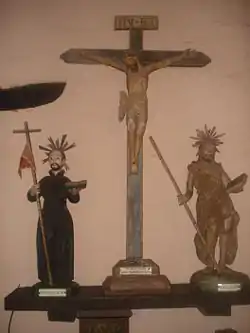Portal:Paraguay
The Paraguay Portal
Paraguay (/ˈpærəɡwaɪ/; Spanish pronunciation: [paɾaˈɣwaj] ( Spanish conquistadores arrived in 1524, and in 1537 established the city of Asunción, the first capital of the Governorate of the Río de la Plata. During the 17th century, Paraguay was the center of Jesuit missions, where the native Guaraní people were converted to Christianity and introduced to European culture. After the expulsion of the Jesuits from Spanish territories in 1767, Paraguay increasingly became a peripheral colony, with few urban centers and settlers. Following independence from Spain in the early 19th century, Paraguay was ruled by a series of authoritarian governments characterized by nationalist, isolationist and protectionist policies. This period ended with the disastrous Paraguayan War (1864–70), during which the country lost half its prewar population and around 25–33% of its territory to the Triple Alliance of Argentina, Brazil and Uruguay. In the 20th century, Paraguay faced another major international conflict—the Chaco War (1932–35) against Bolivia—in which it prevailed. Afterwards, the country came under a succession of military dictators, culminating in the 35-year regime of Alfredo Stroessner, which lasted until his overthrow in 1989 by an internal military coup. This marked the beginning of Paraguay's democratic era, which continues to this day. Paraguay is a developing country, ranking 105th in the Human Development Index. It is a founding member of Mercosur, the United Nations, the Organization of American States, the Non-Aligned Movement and the Lima Group. Additionally, the city of Luque, in metropolitan Asuncion, is the seat of the South American Football Confederation. The majority of Paraguay's seven million people are mestizo, and Guarani culture remains widely influential; more than 90% of the population speak various dialects of the Guarani language alongside Spanish. Paraguay is South America's poorest country and the second poorest South American nation in GDP/per capita. Despite a history of poverty and political repression, in a 2017 Positive Experience Index based on global polling data, Paraguay ranked as the "world's happiest place". (Full article...) Selected article -
The Paraguayan War, also known as the War of the Triple Alliance, was a South American war that lasted from 1864 to 1870. It was fought between Paraguay and the Triple Alliance of Argentina, the Empire of Brazil, and Uruguay. It was the deadliest and bloodiest inter-state war in Latin American history. Paraguay sustained large casualties, but the approximate numbers are disputed. Paraguay was forced to cede disputed territory to Argentina and Brazil. The war began in late 1864, as a result of a conflict between Paraguay and Brazil caused by the Uruguayan War. Argentina and Uruguay entered the war against Paraguay in 1865, and it then became known as the "War of the Triple Alliance." After Paraguay was defeated in conventional warfare, it conducted a drawn-out guerrilla resistance, a strategy that resulted in the further destruction of the Paraguayan military and the civilian population. Much of the civilian population died due to battle, hunger, and disease. The guerrilla war lasted for 14 months until President Francisco Solano López was killed in action by Brazilian forces in the Battle of Cerro Corá on 1 March 1870. Argentine and Brazilian troops occupied Paraguay until 1876. (Full article...)CategoriesCategory puzzle Select [►] to view subcategories
Paraguay Paraguay-related lists 1877 in Paraguay Buildings and structures in Paraguay Paraguayan culture Economy of Paraguay Education in Paraguay Environment of Paraguay Geography of Paraguay Government of Paraguay Health in Paraguay History of Paraguay Organisations based in Paraguay Paraguayan people Politics of Paraguay Society of Paraguay Images of Paraguay Paraguay stubs General imagesThe following are images from various Paraguay-related articles on Wikipedia.
Did you know?TopicsSelected picture Sunset at Villa Florida
WikiProjectsWikiProject Paraguay
Things to doRelated portalsWikimediaThe following Wikimedia Foundation sister projects provide more on this subject:
| ||||||




.jpg.webp)









.svg.png.webp)

.svg.png.webp)













.jpg.webp)












.svg.png.webp)


.jpg.webp)

.svg.png.webp)

.JPG.webp)








.svg.png.webp)





